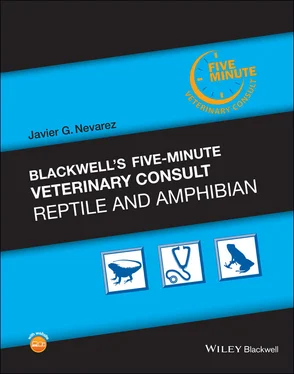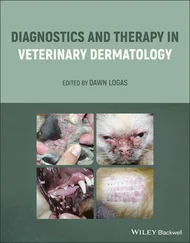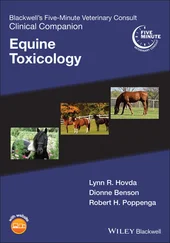Javier G. Nevarez - Blackwell's Five-Minute Veterinary Consult - Reptile and Amphibian
Здесь есть возможность читать онлайн «Javier G. Nevarez - Blackwell's Five-Minute Veterinary Consult - Reptile and Amphibian» — ознакомительный отрывок электронной книги совершенно бесплатно, а после прочтения отрывка купить полную версию. В некоторых случаях можно слушать аудио, скачать через торрент в формате fb2 и присутствует краткое содержание. Жанр: unrecognised, на английском языке. Описание произведения, (предисловие) а так же отзывы посетителей доступны на портале библиотеки ЛибКат.
- Название:Blackwell's Five-Minute Veterinary Consult: Reptile and Amphibian
- Автор:
- Жанр:
- Год:неизвестен
- ISBN:нет данных
- Рейтинг книги:4 / 5. Голосов: 1
-
Избранное:Добавить в избранное
- Отзывы:
-
Ваша оценка:
- 80
- 1
- 2
- 3
- 4
- 5
Blackwell's Five-Minute Veterinary Consult: Reptile and Amphibian: краткое содержание, описание и аннотация
Предлагаем к чтению аннотацию, описание, краткое содержание или предисловие (зависит от того, что написал сам автор книги «Blackwell's Five-Minute Veterinary Consult: Reptile and Amphibian»). Если вы не нашли необходимую информацию о книге — напишите в комментариях, мы постараемся отыскать её.
STAY UP TO DATE ON THE BEST PRACTICES FOR TREATING COMMON DISEASES IN REPTILES AND AMPHIBIANS Blackwell’s Five-Minute Veterinary Consult: Reptile and Amphibian
Blackwell’s Five-Minute Veterinary Consult: Reptile and Amphibian
Blackwell's Five-Minute Veterinary Consult: Reptile and Amphibian — читать онлайн ознакомительный отрывок
Ниже представлен текст книги, разбитый по страницам. Система сохранения места последней прочитанной страницы, позволяет с удобством читать онлайн бесплатно книгу «Blackwell's Five-Minute Veterinary Consult: Reptile and Amphibian», без необходимости каждый раз заново искать на чём Вы остановились. Поставьте закладку, и сможете в любой момент перейти на страницу, на которой закончили чтение.
Интервал:
Закладка:
Being a longer bulb also means that there is more scattered radiation, so the UVB exposure is not as focused. This may actually be of benefit for amphibian enclosures. The use of a shorter bulb, while leaving the rest of the cage shaded, is a preferred setup for amphibians. These bulbs emit UVB light at an average effective distance of 12–20 inches depending on the brand and percent of emitted UVB. It is generally recommended that animals should not have the ability to get any closer than within 3–4 inches of bulb’s surface. They must be replaced every 6–12 months according to manufacturer’s recommendations.
T5 High‐Output Linear Fluorescents
A high‐output light is a T5 bulb (16‐mm or 0.6‐inch diameter) that requires a hood with a T5 fixture. T5 bulbs are more efficient and provide a higher amount of UVB than T8 or compact fluorescent bulbs. In theory, a T5 10.0 bulb produces a higher amount of UVB than a T8 10.0 or compact fluorescent. It is worth mentioning that Zoo Med Laboratories Inc. produces a T8 10.0 bulb labeled high output but their T5 10.0 bulb is actually a much stronger bulb and is considered as a true high output for our purposes. These bulbs emit UVB light at an effective distance of 12–36 inches depending on the brand and percentage of emitted UVB. While it is generally recommended that animals should not be able to get any closer than within 3–4 inches of bulb’s surface, this distance may actually need to be longer for high output bulbs. They must be replaced every 9–12 months, according to manufacturer’s recommendations. T5 bulbs likely produce more UVB than most amphibians should be exposed to, and should be avoided or only used under extreme caution while monitoring UVB exposure levels. As with the T8 bulbs, only those with 5% UVB or less should be used.
Compact Fluorescent
Compact fluorescent bulbs can be fitted into any incandescent fixture that would fit a household bulb but a reflective or reptile‐specific fixture is preferred. The light is focused over a smaller area so there is less scattered radiation. For this reason, it is possible that a 10.0 compact fluorescent may actually emit a higher UVB output than a 10.0 linear fluorescent over the same area. It is usually recommended to place these bulbs next to the heat lamp, so the reptile gets UVB exposure while basking. All other properties are similar to the linear fluorescent bulbs although some may think of these as being less effective and being “weaker” in the UVB spectrum. As with the linear fluorescent bulb, animals should not have the ability to get any closer than within 3–4 inches of bulb’s surface. A 5% or lower should be used for amphibians.
UVB REDUCTION
As previously mentioned, the type of material present between the bulb and the animal is an important consideration when selecting a UVB bulb. Most glass and plastics are known to block or filter out UVB radiation and are not recommended. The ideal scenario is one of an open‐topped enclosure with no material present between the bulb and the animal. While this is a possible application for salamanders and some aquatic species, it is not feasible when housing anurans and other species. A study by Burger et al revealed the UVB attenuating effects of common materials used in reptile enclosures and provides a sobering insight into the use of UVB bulbs (Burger et al, 2007). The type of material, aperture of the openings, thickness, and reflective properties can all influence UVB attenuation and can significantly decrease the UVB exposure of reptiles. Most amphibian enclosures have a screen or wire mesh top to keep the animals from escaping. Some of these screens may reduce the UVB light exposure to the animal by as much as 50%. To put this in perspective, if a reptile had a 5% linear fluorescent bulb, the effectiveness of that bulb might be reduced to that of a 2.5% by the time the light passes the screen and reaches the animal. This is why knowing the type of screen material is critical when selecting a bulb. A general recommendation is to select a screen with the largest aperture possible and with a mat or painted finish that will reflect less light.
SELECTING BULBS BASED ON SPECIES
There is a common trend toward make recommendations of bulbs based on the species with which it will be used. The principle behind this makes sense but in practice it is flawed. The thought is that certain species require higher UVB exposure and therefore a stronger UVB bulb while others require a lower UVB exposure and therefore a weaker bulb according to their biology and behavior. These principles would hold true in open‐topped enclosures without a lid or when the bulb is placed inside the enclosure. However as mentioned previously, when the bulb is placed atop a screen, it can block a significant portion of the UVB reaching the animal. The author therefore recommends selecting a bulb not simply based on the species but rather a combination of the species and the specific enclosure setup of the particular animal. Buying a UVB bulb from a reputable manufacturer that provides clear guidance as to how to use the bulbs is the first step in safe use of UVB bulbs. The second aspect is ensuring that the owners and caretakers are indeed using the bulbs in the safest, most efficient manner for the particular species.
MEASURING UVB
Another challenge in selecting the proper UVB bulb is the fact that bulb strength or percentage UVB emission does not directly translate to its effectiveness in stimulating vitamin D3 synthesis in the body. There are in vitro models to assess the efficiency of UVB light (Burger et al, 2007) but these are impractical in a clinical setting. We must rely on the reputation of the manufacturer to ensure that the bulb is of good enough quality. How much UVB a particular amphibian species requires is unknown at this time. In nature, UVB exposure will vary with time of day, cloud covering, and so on, but in captivity the exposure level will be fairly constant while the bulb is turned on. Providing hiding places and a gradient of UVB light can help to reduce UVB overexposure for amphibians. An additional consideration is to only turn the UVB lights on for 2–4 hours of daily or every other day exposure.
Radiometers
UVB irradiance cab be measured using a hand‐held radiometer. While expensive (approximately $250.00) these units are available to the general public. Their accuracy has been questioned, but they remain a good tool. A radiometer can be used to measure UVB irradiance of a bulb at any distance to determine how much UVB is being emitted and to record the decay of transmission over time. For example a 5% linear fluorescent bulb may emit 25 μW/cm 2at 12 inches when first purchased but, after 6 months, the irradiance at 12 inches may have decreased to 12 μW/cm 2. While this may still be acceptable exposure, it certainly indicates decrease in the bulb’s effectiveness over time. This decay is normal but if one desires to provide a more constant UVB exposure year round, it may be time to purchase a new bulb. They can also be used to evaluate the effect of the screen or mesh cover on the effectiveness of a bulb to help clients select the most appropriate bulb for their setup. Some newer radiometers measure ultraviolet index providing scale from minimum to very high while others provide readout based on the Ferguson zones to help determine the UVB exposure. These radiometers are advertised as being able to measure the appropriate UVB dose for vitamin D3 synthesis although that claim has not been verified. Most amphibians should be exposed to a Ferguson zone of 1 or 2 maximum and no higher.
CALCIUM SUPPLEMENTATION
All animals need a source of calcium and a calcium to phosphorus ratio of 1.5 : 2. Most invertebrates have a negative calcium to phosphorus ratio, so animals must find other sources of calcium. In their natural environment, these animals will seek out mineral deposits or particular feedstuffs to supplement their calcium intake. In captivity, amphibians do not have the opportunity to seek calcium sources but rather rely on it being supplemented in their diet. Various commercial sources of calcium are available, but some are better than others. First, it is recommended that calcium supplements be purely calcium with no phosphorus or vitamin D3. While many see a benefit of adding a D3 supplement, there are serious and real concerns about oversupplementation of vitamin D3. Adding a calcium supplement that also contains phosphorus does not make sense because the amphibians are already in a negative calcium to phosphorus imbalance. Adding more phosphorus would not help solve this imbalance in an effective manner. The author prefers calcium only supplements including calcium powders sold for reptiles, cuttle bones, and crushed oyster shells. Another alternative is the use of fruit‐flavored calcium carbonate antacid tablets. These tables are more palatable than other products. They can be pulverized or fed in small pieces.
Читать дальшеИнтервал:
Закладка:
Похожие книги на «Blackwell's Five-Minute Veterinary Consult: Reptile and Amphibian»
Представляем Вашему вниманию похожие книги на «Blackwell's Five-Minute Veterinary Consult: Reptile and Amphibian» списком для выбора. Мы отобрали схожую по названию и смыслу литературу в надежде предоставить читателям больше вариантов отыскать новые, интересные, ещё непрочитанные произведения.
Обсуждение, отзывы о книге «Blackwell's Five-Minute Veterinary Consult: Reptile and Amphibian» и просто собственные мнения читателей. Оставьте ваши комментарии, напишите, что Вы думаете о произведении, его смысле или главных героях. Укажите что конкретно понравилось, а что нет, и почему Вы так считаете.












